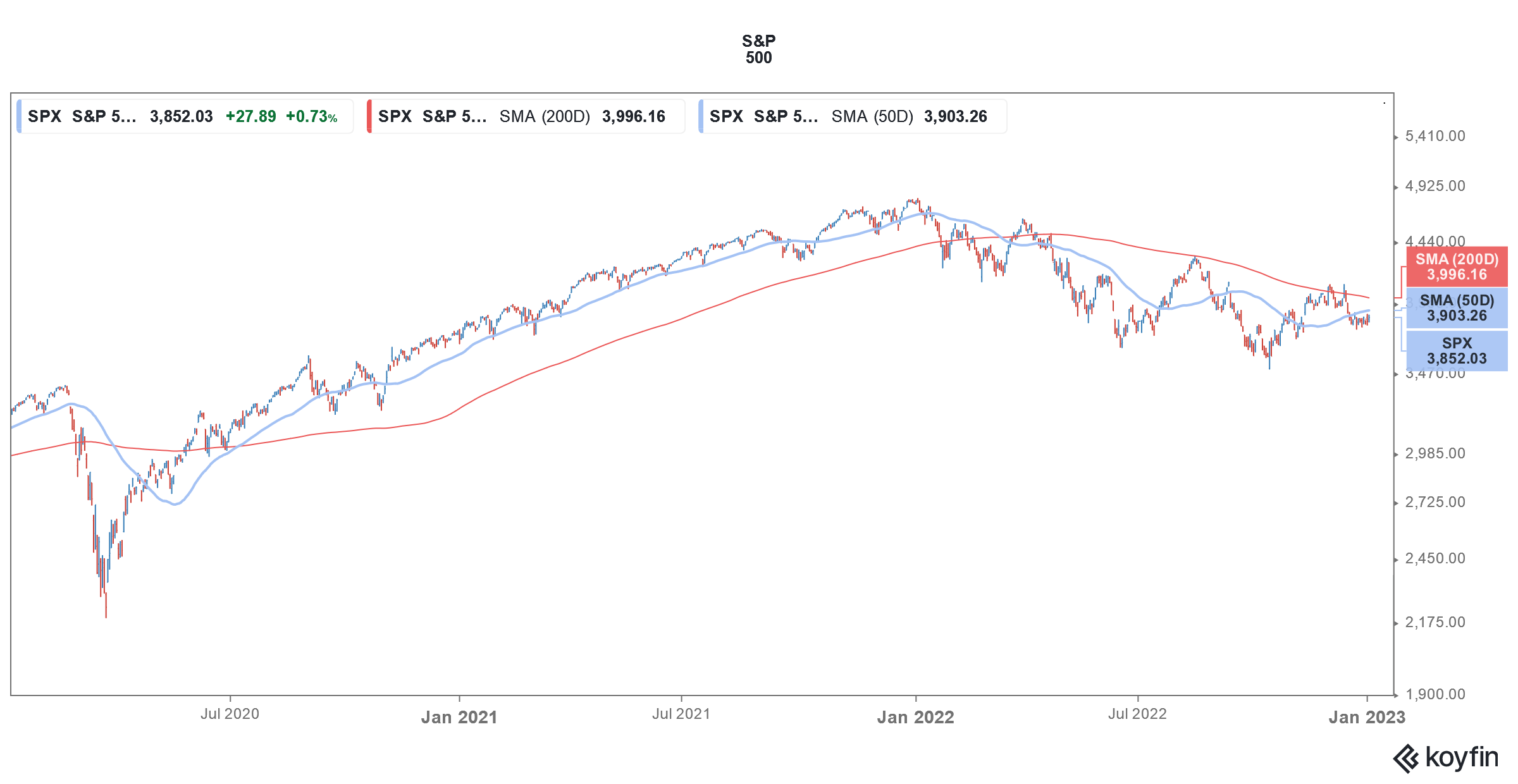Yesterday, the US Federal Reserve released the minutes of its December meeting where it had raised rates by 50 basis points as widely expected. Here are the key takeaways from the minutes of the Fed’s December meeting.
The minutes state that “incoming data showed nascent signs of a moderation in inflationary pressures.” Notably, the headline US CPI rose at an annualized pace of 7.1% in November which was lower than expected. The pace of price rise has fallen by 2 percentage points since June when the CPI rose at an annualized pace of 9.1%.
The personal consumption expenditures price index less food and energy, which is the Fed’s preferred inflation index rose at an annualized pace of 4.7% in November. The gauge peaked at 5.4% last year but is still over twice the 2% that the Federal Reserve targets.
Key takeaways from Federal Reserve’s December minutes
The minutes of Federal Reserve’s December meeting show that the US central bank is still worried about inflation and not giving up its fight. The minutes stated, “Participants generally noted that the uncertainty associated with their economic outlooks was high and that the risks to the inflation outlook remained tilted to the upside.”
They added, Participants cited the possibility that price pressures could prove to be more persistent than anticipated, due to, for example, the labor market staying tight for longer than anticipated.”
Notably, previously also Federal Reserve chair Jerome Powell has expressed concern over the tight labor market and rising wages.
Powell is concerned about the tight labor market
He said, that the US job market “shows only tentative signs of rebalancing, and wage growth remains well above levels that would be consistent with 2% inflation.”
Despite layoffs at several companies, the US job market has been quite strong. The unemployment rate is 3.7% which is low by historical standards.
While Powell admitted that strong wage growth “is a good thing” he added, “For wage growth to be sustainable, it needs to be consistent with 2% inflation.” Meanwhile, many economists disagree with Powell on wage growth and point out that in real terms wage growth is actually negative as it is below the rise in inflation.
Federal Reserve is Looking to Raise Rates Furter
The Federal Reserve raised rates by 50 basis points in December. It was preceded by four consecutive rate hikes of 75 basis points. While the Fed slowed down the pace of the hike in December, the minutes cautioned against reading too much into it.
The minutes stated, “A number of participants emphasized that it would be important to clearly communicate that a slowing in the pace of rate increases was not an indication of any weakening of the Committee’s resolve to achieve its price-stability goal or a judgment that inflation was already on a persistent downward path.”
Powell cautioned against premature easing
On multiple occasions, the Federal Reserve has cautioned against premature easing. While markets were expecting the Fed to pivot to rate cuts, Powell dashed all hopes at the Jackson Hole Symposium in August.
The Federal Reserve raised rates to 4.25-4.50% last year. The December dot plot showed that FOMC members see rates rising to 5-5.25% by the end of 2023. Markets expect the Fed to raise rates by another 75 basis points in 2023.
Federal Reserve wants to maintain a restrictive monetary policy
The Federal Reserve’s December minutes state “Participants generally observed that a restrictive policy stance would need to be maintained until the incoming data provided confidence that inflation was on a sustained downward path to 2 percent, which was likely to take some time.”
They added, “In view of the persistent and unacceptably high level of inflation, several participants commented that historical experience cautioned against prematurely loosening monetary policy.”
Recession fears rise
Many economists fear that the Federal Reserve’s rate hikes would push the US economy into a recession. The minutes of the Fed’s December meeting acknowledged recession fears.
They stated, “the sluggish growth in real private domestic spending expected over the next year, a subdued global economic outlook, and persistently tight financial conditions were seen as tilting the risks to the downside around the baseline projection for real economic activity, and the staff still viewed the possibility of a recession sometime over the next year as a plausible alternative to the baseline.”
Powell is meanwhile still hopeful that the US economy can avert a recession and the US central bank can steer the world’s largest economy towards a soft landing.
Economists want the Federal Reserve to cut rates
Tesla’s CEO Elon Musk wants the Federal Reserve to immediately cut rates in order to avert a recession. Musk has warned of a recession previously also and also cut Tesla’s workforce. He also fired half of Twitter’s employees after he acquired the company.
Tesla stock meanwhile has been in a freefall since Musk acquired Twitter. Surveys show that Tesla’s brand has taken a hit after Musk’s Twitter acquisition.
Many other economists also believe that the Federal Reserve is making the mistake of overtightening. Cathie Wood has also mocked the Fed for being too aggressive with its rate hikes.
US stocks crashed in 2022
Federal Reserve’s rate hikes took a toll on US stock markets in 2022 and some analysts believe that 2023 would be no better. Hedge fund manager Dan Niles whose long-short fund outperformed the markets in 2022 sees US stocks hitting new lows in 2023.
Niles listed high inflation, rising interest rates, high inflation, and a slowdown in earnings as a bearish drivers for US stocks.
Niles is not alone in predicting a new low for US stocks in 2023. Mike Wilson, Morgan Stanley’s chief US equity strategist, who correctly predicted the 2022 stock market crash, is not too bullish on the markets heading into 2023.
Wilson sees the S&P 500 falling to as low as 3,000 in the first four months of 2023. He said, “That’s when we think the deacceleration on the revisions on the earnings side will kind of reach its crescendo.”
Trusted & Regulated Stock & CFD Brokers
What we like
- 0% Fees on Stocks
- 5000+ Stocks, ETFs and other Markets
- Accepts Paypal Deposits
Min Deposit
$200
Charge per Trade
Zero Commission on real stocks
64 traders signed up today
Visit Now67% of retail investor accounts lose money when trading CFDs with this provider. You should consider whether you can afford to take the high risk of losing your money.
Available Assets
- Total Number of Stocks & Shares5000+
- US Stocks
- German Stocks
- UK Stocks
- European
- ETF Stocks
- IPO
- Funds
- Bonds
- Options
- Futures
- CFDs
- Crypto
Charge per Trade
- FTSE 100 Zero Commission
- NASDAQ Zero Commission
- DAX Zero Commission
- Facebook Zero Commission
- Alphabet Zero Commission
- Tesla Zero Commission
- Apple Zero Commission
- Microsoft Zero Commission
Deposit Method
- Wire Transfer
- Credit Cards
- Bank Account
- Paypall
- Skrill
- Neteller
What we like
- Sign up today and get $5 free
- Fractals Available
- Paypal Available
Min Deposit
$0
Charge per Trade
$1 to $9 PCM
Visit Now
Investing in financial markets carries risk, you have the potential to lose your total investment.
Available Assets
- Total Number of Shares999
- US Stocks
- German Stocks
- UK Stocks
- European Stocks
- EFTs
- IPOs
- Funds
- Bonds
- Options
- Futures
- CFDs
- Crypto
Charge per Trade
- FTSE 100 $1 - $9 per month
- NASDAQ $1 - $9 per month
- DAX $1 - $9 per month
- Facebook $1 - $9 per month
- Alphabet $1 - $9 per month
- Telsa $1 - $9 per month
- Apple $1 - $9 per month
- Microsoft $1 - $9 per month
Deposit Method
- Wire Transfer
- Credit Cards
- Bank Account




